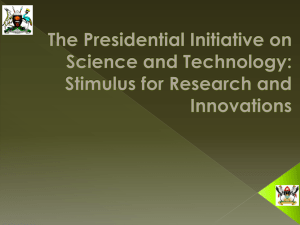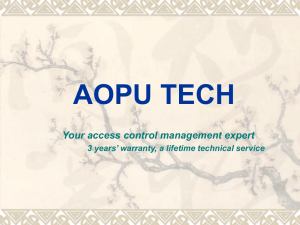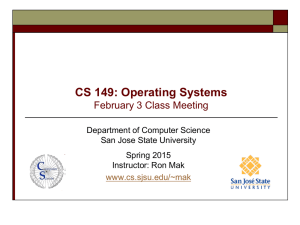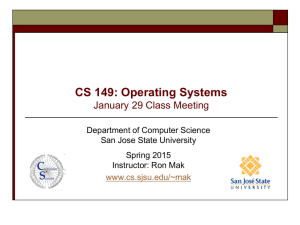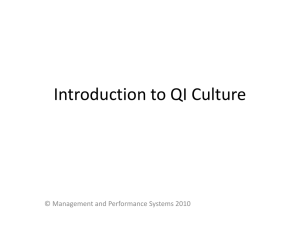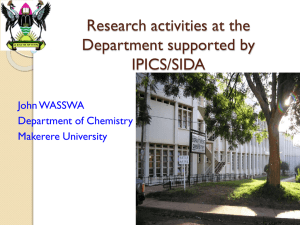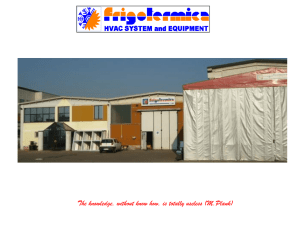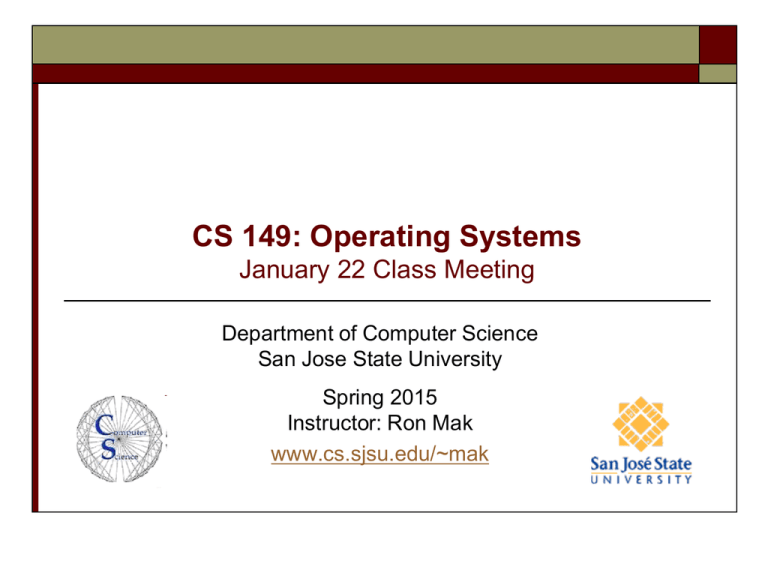
CS 149: Operating Systems
January 22 Class Meeting
Department of Computer Science
San Jose State University
Spring 2015
Instructor: Ron Mak
www.cs.sjsu.edu/~mak
Basic Info
Office hours
TuTh 7:30 - 8:30 PM
MH 413
Class website
http://www.cs.sjsu.edu/~mak/
Green sheet
Assignments
Lecture notes
Computer Science Dept.
Spring 2015: January 22
CS 149: Operating Systems
© R. Mak
2
Project Teams
Assignments will be done by
small project teams.
Form your own teams of 3 or 4 members each.
Choose your team members wisely!
Be sure you’ll be able to meet and communicate
with each other and work together well.
No moving from team to team.
Computer Science Dept.
Spring 2015: January 22
CS 149: Operating Systems
© R. Mak
3
Project Teams, cont’d
Each team member will receive the same score
on each team assignment and team project.
Each team email to ron.mak@sjsu.edu
by Monday, January 26:
Your team name
A list of team members and email addresses
Subject: CS 149-n Team Team Name
Where n is your section number (2, 3, or 8)
Example: CS 149-3 Team Super Coders
Computer Science Dept.
Spring 2015: January 22
CS 149: Operating Systems
© R. Mak
4
Individual Responsibilities
You are personally responsible for participating
and contributing to your team’s work, and for
understanding each part of the work for every
assignment whether or not you worked on that part.
Computer Science Dept.
Spring 2015: January 22
CS 149: Operating Systems
© R. Mak
5
Postmortem Assessment Report
At the end of the semester, each student will
individually turn in a short (one page) report:
A brief description of what you learned in the course.
An assessment of your personal accomplishments
for your project team.
An assessment of each of
your project team members.
_
Computer Science Dept.
Spring 2015: January 22
CS 149: Operating Systems
© R. Mak
6
Your Individual Overall Class Grade
65% assignments (team scores)
15% midterm exam (individual score)
20% final exam (individual score)
Final letter grade based on the class curve.
Computer Science Dept.
Spring 2015: January 22
CS 149: Operating Systems
© R. Mak
7
Participation is Important
Can move your final grade up or down,
especially in borderline cases.
Participation in class.
Participation in your team.
As reported by the postmortem assessment reports.
Computer Science Dept.
Spring 2015: January 22
CS 149: Operating Systems
© R. Mak
8
Take roll!
Computer Science Dept.
Spring 2015: January 22
CS 149: Operating Systems
© R. Mak
9
What is an Operating System?
The layer of “system software”
between the machine hardware
and the application programs.
Operating Systems: Design and Implementation
Tanenbaum & Woodhull
(c) 2006 Prentice-Hall, Inc. All rights reserved. 0-13-142938-8
Computer Science Dept.
Spring 2015: January 22
CS 149: Operating Systems
© R. Mak
10
Why Study Operating Systems?
Become a better programmer.
Become a power computer user.
Your applications can make better use
of the underlying system.
Be a systems programmer.
Understand how to invoke OS services
at the command line.
Be able to write shell scripts.
Become a better computer designer.
Understand hardware and software tradeoffs.
Computer Science Dept.
Spring 2015: January 22
CS 149: Operating Systems
© R. Mak
11
Purpose of an Operating System
An extended machine or virtual machine
Easier to use and program
than the underlying hardware.
A resource manager
Programs share resources in time and space.
Computer Science Dept.
Spring 2015: January 22
CS 149: Operating Systems
© R. Mak
12
What Resources Does an OS Manage?
CPUs
Main memory
disk management
file management
I/O devices
memory management
Data storage
process management
I/O management
Networking, virtualization, security, etc.
Computer Science Dept.
Spring 2015: January 22
CS 149: Operating Systems
© R. Mak
13
Abstractions
An operating systems provides abstractions
of the computer system.
Abstractions are useful for computer users
and for software developers.
Computer Science Dept.
Spring 2015: January 22
CS 149: Operating Systems
© R. Mak
14
Abstractions, cont’d
CPU multiple processes
Physical memory virtual memory
Process: A program that is running
locally or remotely.
Processes can simultaneously occupy
more memory than is physically available.
Disk storage files
Don’t worry about allocating space on disk drives
that are local or on a network server.
Computer Science Dept.
Spring 2015: January 22
CS 149: Operating Systems
© R. Mak
15
UNIX as an Example OS
In this class, we will use UNIX
as an example operating system.
We will write system calls using the C
language.
Install Debian Linux on your PC or Mac
as a virtual machine.
Computer Science Dept.
Spring 2015: January 22
CS 149: Operating Systems
© R. Mak
16
VirtualBox (PC and Mac)
Challenging to set up, but very powerful.
Free software from Oracle: https://www.virtualbox.org/
Latest version is 4.3.20
Download the Debian ISO file.
Debian Linux distro: http://www.debian.org/distrib/
Latest version is 7.8.0
Download "small installation image" which is a .iso file.
ISO: optical disk image: a .iso file
Computer Science Dept.
Spring 2015: January 22
CS 149: Operating Systems
© R. Mak
17
VirtualBox (PC and Mac), cont’d
Load the Debian ISO file into VirtualBox
to create a Debian virtual machine (VM).
You can run multiple VMs simultaneously,
each with a different operating system.
Subject to your disk and memory limitations.
Also install VirtualBox “guest additions”
Allows you to mount a shared folder
that is accessible by both
Installation demo
the VM and the host machine.
next Tuesday.
Computer Science Dept.
Spring 2015: January 22
CS 149: Operating Systems
© R. Mak
18
Operating System Generations
Generation 1 (1945 – 55)
Generation 2 (1955 – 65)
Transistors and batch systems
Generation 3 (1965 – 80)
Vacuum tubes and plugboards
ICs and multiprogramming
Generation 4 (1980 – Present)
Personal and mobile computers
_
Computer Science Dept.
Spring 2015: January 22
CS 149: Operating Systems
© R. Mak
19
Historical Perspective
Early batch computer systems
a)
Programmers bring punched cards
to the IBM 1401 computer system.
b)
The1401 reads a
batch of jobs onto tape.
Operating Systems: Design and Implementation
Tanenbaum & Woodhull
(c) 2006 Prentice-Hall, Inc. All rights reserved. 0-13-142938-8
Computer Science Dept.
Spring 2015: January 22
CS 149: Operating Systems
© R. Mak
20
Historical Perspective, cont’d
Early batch computer systems
c)
d)
A computer operator carries the input tape
to a “large scale” IBM 7094.
The 7094 does
the computing.
Operating Systems: Design and Implementation
Tanenbaum & Woodhull
(c) 2006 Prentice-Hall, Inc. All rights reserved. 0-13-142938-8
Computer Science Dept.
Spring 2015: January 22
CS 149: Operating Systems
© R. Mak
21
Historical Perspective, cont’d
Early batch computer systems
e)
f)
The operator carries the output tape
to the IBM 1401.
The 1401 prints output.
Operating Systems: Design and Implementation
Tanenbaum & Woodhull
(c) 2006 Prentice-Hall, Inc. All rights reserved. 0-13-142938-8
Computer Science Dept.
Spring 2015: January 22
CS 149: Operating Systems
© R. Mak
22
What was the IBM 1401?
A “small scale” computer system
developed by IBM in the late 1950s.
1402 Card Read Punch
Computer Science Dept.
Spring 2015: January 22
1407 Console
1401 CPU
CS 149: Operating Systems
© R. Mak
729 Tape Drive
1403 Line Printer
23
Computing Before the IBM 1401
Business data processing involved applications
that manipulated data records:
Inventory
Billing and receivables
Payroll
Computer Science Dept.
Spring 2015: January 22
CS 149: Operating Systems
© R. Mak
24
Computing Before the IBM 1401
Data was stored in
punched cards called
“IBM cards” or
“Hollerith cards”
Computer Science Dept.
Spring 2015: January 22
CS 149: Operating Systems
© R. Mak
Named after
Herman Hollerith.
80 columns per card,
one character per
column.
Up to 12 punched holes
per column.
Alphanumeric data,
often grouped
into fields.
25
Computing Before the IBM 1401
A data processing application involved
passing decks of punched cards through
electromechanical “unit record” machines.
Repetitive sort, calculate, collate, and tabulate
operations ...
... were programmed with hand-wired
plugboard control panels.
_
Computer Science Dept.
Spring 2015: January 22
CS 149: Operating Systems
© R. Mak
26
Plugboard Control Panel
IBM 407 Accounting Machine (1949)
Computer Science Dept.
Spring 2015: January 22
CS 149: Operating Systems
© R. Mak
27
Programming a Plugboard
“Programming”
was hand-wiring
plugboards.
“Hmm, should I pass this parameter
by value or by reference?”
Computer Science Dept.
Spring 2015: January 22
CS 149: Operating Systems
© R. Mak
28
Data Processing
Computer Science Dept.
Spring 2015: January 22
CS 149: Operating Systems
© R. Mak
29
Data Processing
Computer Science Dept.
Spring 2015: January 22
Cards were punched
manually at a
keypunch machine.
Or they were punched
automatically by
unit-record equipment
under program control.
CS 149: Operating Systems
© R. Mak
30
Running a Data Processing Application ...
... meant passing decks of cards
through a sequence of unit-record machines.
Each machine was programmed via its plugboard
to perform its task for the application.
Each machine had little or no memory.
The punched cards stored the data records
The data records moved as the cards moved.
An entire work culture evolved around punched cards!
Computer Science Dept.
Spring 2015: January 22
CS 149: Operating Systems
© R. Mak
31
A Data Processing Job
A typical “job”.
Operating Systems: Design and Implementation
Tanenbaum & Woodhull
(c) 2006 Prentice-Hall, Inc. All rights reserved. 0-13-142938-8
Computer Science Dept.
Spring 2015: January 22
CS 149: Operating Systems
© R. Mak
32
A Data Processing Program
Data processing
was all about
punched cards.
My school compiler project:
Computer Science Dept.
Spring 2015: January 22
3½ boxes of punched cards
Each box = 2000 cards, 10 lbs.
CS 149: Operating Systems
© R. Mak
33
The IBM 1401 Computer System
Memory was a limited resource.
The main CPU unit contained up to 4K characters of
core memory (1 character = 8 bits).
You could add the IBM 1406 memory unit which
contained up to 12K of additional memory
Maximum memory was 16K.
K = 1000
In the 1401, each core bit cost
60¢ ($3/bit in today’s dollars).
Computer Science Dept.
Spring 2015: January 22
CS 149: Operating Systems
© R. Mak
34
The IBM 1401 Computer System
The 1401 computer system had amazing peripherals
(I/O devices).
1403 Line Printer
1402 Card Reader Punch
729 Magnetic Tape Drives
Disk drives became available later.
Computer Science Dept.
Spring 2015: January 22
CS 149: Operating Systems
© R. Mak
35
The 1401 Architecture
11.5 microsecond clock cycle
Add two decimal digits in one cycle, or
Move one character between memory and a
peripheral
87 KHz
Today’s 4 GHz PC can add two 20-digit numbers
about 1 million times faster than a 1401.
A single laptop computer today has more computing
power than all the 1401 systems ever installed.
Computer Science Dept.
Spring 2015: January 22
CS 149: Operating Systems
© R. Mak
36
How the 1401 Transformed Data Processing
It was cheap enough for small businesses.
Programs were stored in main memory.
No more plugboards!
Transferred data from punched cards
to magnetic tape and disk.
Customers could program their own machines.
Autocoder assembly language.
“High level” languages:
FORTRAN, COBOL, RPG
Computer Science Dept.
Spring 2015: January 22
CS 149: Operating Systems
© R. Mak
37
The 1401 Had No Operating System!
Only one program ran at a time.
The program had full control of the machine.
Programmers had to know how to code
instructions to read and write the I/O devices.
Example: The read instruction read the contents
of the next card from the card reader into
memory locations 101-180.
Example: The print instruction printed whatever
was in memory locations 201-332 to the next line
of the line printer.
The card reader and line printer were
directly connected to the CPU
Computer Science Dept.
Spring 2015: January 22
CS 149: Operating Systems
© R. Mak
38


